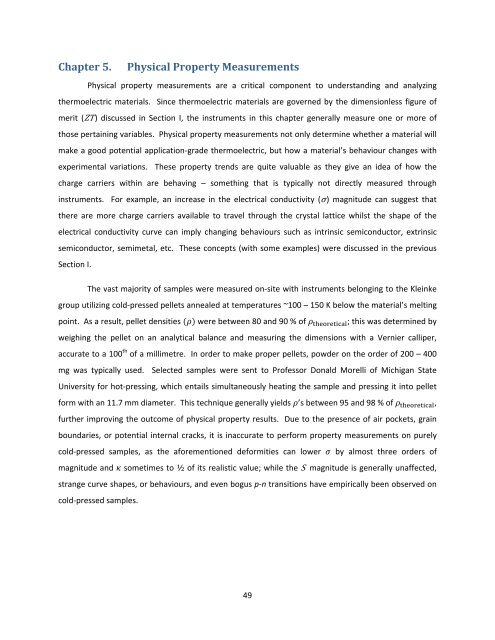Exploration and Optimization of Tellurium‐Based Thermoelectrics
Exploration and Optimization of Tellurium‐Based Thermoelectrics
Exploration and Optimization of Tellurium‐Based Thermoelectrics
Create successful ePaper yourself
Turn your PDF publications into a flip-book with our unique Google optimized e-Paper software.
Chapter 5. Physical Property Measurements<br />
Physical property measurements are a critical component to underst<strong>and</strong>ing <strong>and</strong> analyzing<br />
thermoelectric materials. Since thermoelectric materials are governed by the dimensionless figure <strong>of</strong><br />
merit (ZT) discussed in Section I, the instruments in this chapter generally measure one or more <strong>of</strong><br />
those pertaining variables. Physical property measurements not only determine whether a material will<br />
make a good potential application‐grade thermoelectric, but how a material’s behaviour changes with<br />
experimental variations. These property trends are quite valuable as they give an idea <strong>of</strong> how the<br />
charge carriers within are behaving – something that is typically not directly measured through<br />
instruments. For example, an increase in the electrical conductivity (σ) magnitude can suggest that<br />
there are more charge carriers available to travel through the crystal lattice whilst the shape <strong>of</strong> the<br />
electrical conductivity curve can imply changing behaviours such as intrinsic semiconductor, extrinsic<br />
semiconductor, semimetal, etc. These concepts (with some examples) were discussed in the previous<br />
Section I.<br />
The vast majority <strong>of</strong> samples were measured on‐site with instruments belonging to the Kleinke<br />
group utilizing cold‐pressed pellets annealed at temperatures ~100 – 150 K below the material’s melting<br />
point. As a result, pellet densities were between 80 <strong>and</strong> 90 % <strong>of</strong> ; this was determined by<br />
weighing the pellet on an analytical balance <strong>and</strong> measuring the dimensions with a Vernier calliper,<br />
accurate to a 100 th <strong>of</strong> a millimetre. In order to make proper pellets, powder on the order <strong>of</strong> 200 – 400<br />
mg was typically used. Selected samples were sent to Pr<strong>of</strong>essor Donald Morelli <strong>of</strong> Michigan State<br />
University for hot‐pressing, which entails simultaneously heating the sample <strong>and</strong> pressing it into pellet<br />
form with an 11.7 mm diameter. This technique generally yields ’s between 95 <strong>and</strong> 98 % <strong>of</strong> ,<br />
further improving the outcome <strong>of</strong> physical property results. Due to the presence <strong>of</strong> air pockets, grain<br />
boundaries, or potential internal cracks, it is inaccurate to perform property measurements on purely<br />
cold‐pressed samples, as the aforementioned deformities can lower by almost three orders <strong>of</strong><br />
magnitude <strong>and</strong> sometimes to ½ <strong>of</strong> its realistic value; while the S magnitude is generally unaffected,<br />
strange curve shapes, or behaviours, <strong>and</strong> even bogus p‐n transitions have empirically been observed on<br />
cold‐pressed samples.<br />
49
















